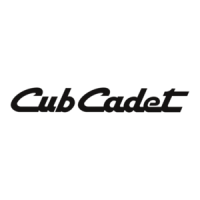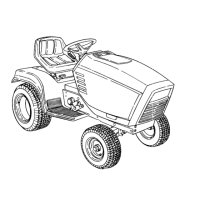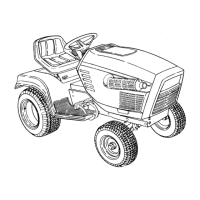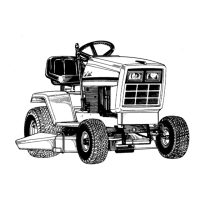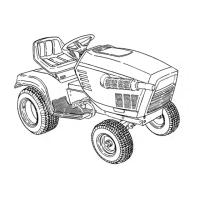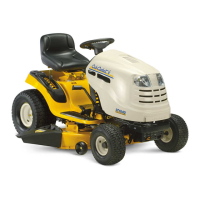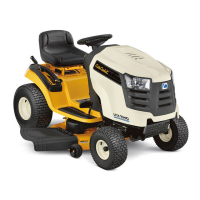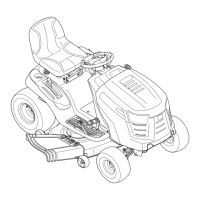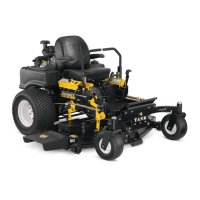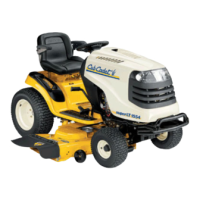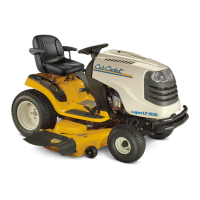17
PRODUCT CARE
Cleaning the Underside of the Deck
Rinse grass clippings from the deck’s underside and prevent the buildup of corrosive chemicals.
WARNING
Make certain the mower’s discharge chute is directed AWAY from people, your house, garage,
parked cars, etc.
1. Disengage the PTO, set the parking brake and stop the engine.
2. Use a hose to spray the underside of the deck.
NOTE: Make sure that the hose is not routed under the deck and is clear of all moving parts.
3. After cleaning your deck, return to the operator’s platform and engage the PTO. Keep the deck running for a
minimum of two minutes, allowing the underside of the deck to thoroughly dry.
Cleaning the Mower
WARNING
If the mower has been recently run, the engine, muffler and surrounding metal surfaces will
be hot and can cause burns to the skin. Let the engine cool for at least five minutes. Exercise
caution to avoid burns.
Your mower should be cleaned after each use and under certain conditions, i.e. dry conditions and/or
mulching situations, additional cleaning may be necessary.
One of the best ways to keep your mower running efficiently and to reduce fire risk is to regularly remove
debris buildup from the mower. Follow the recommendations below and contact your authorized dealer
with any questions.
• Allow the machine to cool in an open area before cleaning.
• Do not use water on any part of the mower except the underside of the cutting deck. Doing so can
cause damage to the mower’s spindle bearings, electrical system and engine, leading to premature
failures. The use of compressed air and/or leaf blower will help keep the mower clean.
• Clean around the exhaust manifold, fuses, all wiring and harnesses, muffler pipe, muffler shield,
engine intake screens and cooling fins, etc (Figure 18).
Figure 18
• Clean the top of the mower deck, under the spindle covers and belt area (Figure 19).
Figure 19
• Clean around and near the transmission, axle and the fan area (Figure 20).
NOTE: Wheel not
shown for clarity.
Figure 20
• Debris can accumulate anywhere on the mower, especially on horizontal surfaces. Additional
cleaning may be necessary when mowing in dry conditions or when mulching.
• Fuel leaks/spills, oil leaks/spills and excess lubrication can also become collections sites for debris.
Immediate repair and cleaning up oil or fuel spills can help reduce fire hazards.
• In addition to cleaning the mower before operating and storing, do not attempt to mow unusually
tall grass (10” or higher), dry grass (e.g., pasture) or piles of dry leaves. Dry grass or leaves may
contact the engine exhaust and/or build up on the mower deck presenting a potential fire hazard.
Lubrication
Periodically lubricate all pivot points with a quality lubricating oil.
Storing the Mower
• Allow the machine to cool in an open area before storing.
• Do not park the mower near any flammable materials (wood, cloth or chemicals) or any open flames
or other potential source of ignition (furnace, water heater or any other type of heater).
• Remove all combustible materials from the mower before storing. Empty cargo boxes, grass catchers
or containers.
• Check the fuel system (lines, tank, cap and fittings) frequently for cracks or leaks. Repair and clean
as necessary.
ENGINE CARE
Refer to the Engine Operator’s Manual for all engine maintenance intervals, procedures, specifications
and instructions.
Changing the Engine Oil
WARNING
If the engine has been recently run, the engine, muffler and surrounding metal surfaces will
be hot and can cause burns to the skin. Exercise caution to avoid burns.
Maintain oil level as instructed in Engine Operator’s Manual. Be careful not to spill oil on any of the belts.
To complete an oil change, proceed as follows:
1. Run the engine for a short time to warm the engine oil. The oil will flow more freely and carry away
more impurities. Use care to avoid burns from hot oil.
2. Locate the oil drain hose on the engine (Figure 21).
Figure 21
3. Route the free end of the oil drain hose through the hole in the mower frame toward an appropriate
oil collection container with at least a 2.5 quart (2.65 Liter) capacity, to collect the used oil.
NOTE: Avoid getting oil on the muffler when draining.
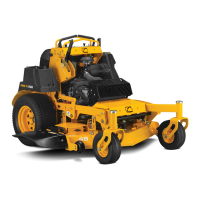
